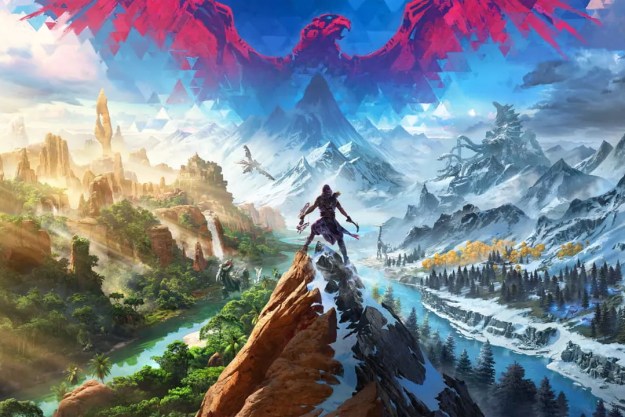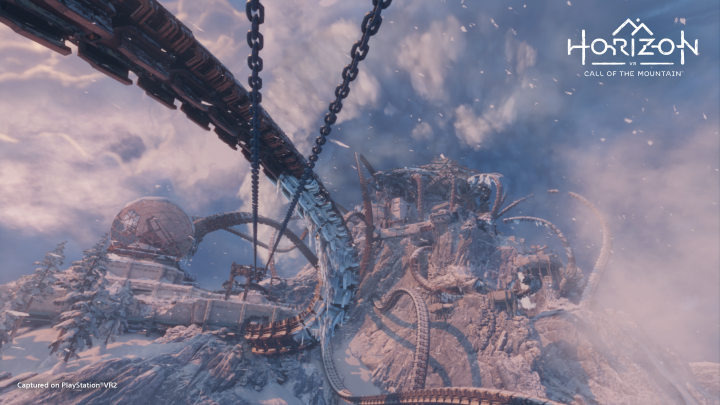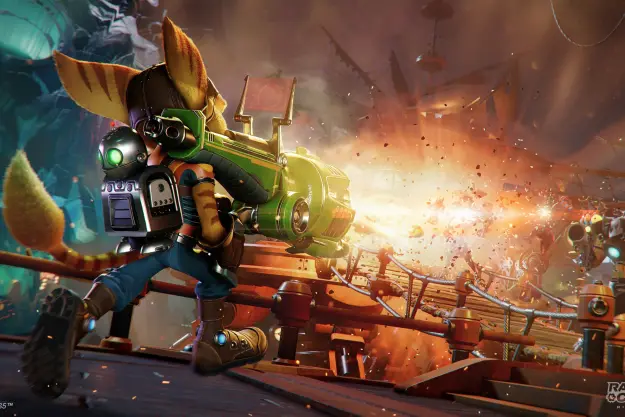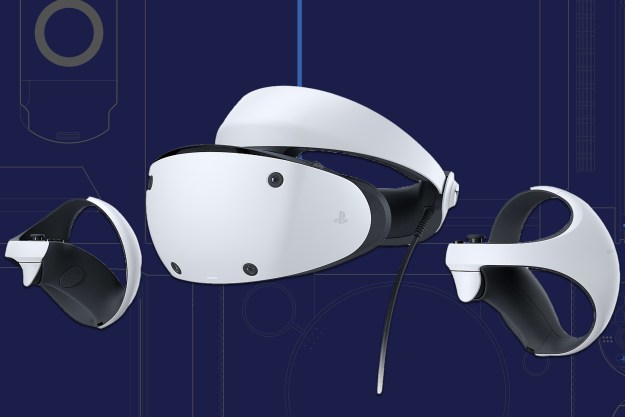
“Horizon Call of the Mountain works as an impressive PSVR2 tech showcase, but overambitious ideas make it less appealing as an action-adventure game.”
- Gorgeous landscapes
- Excellent sense of scale
- Physical climbing
- Bow feels excellent
- Flat story and hero
- Finnicky VR interactions
- Overly complex combat
As I scale an enormous robot-dinosaur skeleton in Horizon Call of the Mountain, hanging impossibly high over the world below, I realize how far my relationship with VR has come.
When I first demoed the tech 10 years ago, I encountered a striking moment where my real-life fear of heights went digital. During a curated demo reel of experiences, I stepped onto a thin plank of wood suspended between skyscrapers. I suddenly noticed that my body had instinctively scrunched up, bracing me for a potential fall as best I could. I imagined moviegoers seeing The Arrival of a Train at La Ciotat Station, screaming in terror as they thought the locomotive was going to barrel into the camera lens and pop out of the screen. I knew I wasn’t in physical danger, but that didn’t change the thrill I felt in the moment.
Now here I was a decade later, entirely unphased as I precariously dangled from a far more intimidating height without a care in the world.
That dynamic highlights a notable change in how the bar has moved for VR games. “Immersive experiences” aren’t enough to carry a VR game in 2023; they need to be as strong and as mechanically sound and engaging as any console game. That’s where Horizon Call of the Mountain finds itself stuck between a rock and, well, another rock. As PlayStation VR2’s first major release, the action-adventure title successfully plays the role of a tech demo that can show off the headset’s new features and technical capabilities. Though it has a tougher time balancing that with its wider ambitions, balancing deep gameplay systems with simple interactions that feel like a tutorial for Sony’s new Sense controllers. That makes for a mixed launch game that’ll be more impressive the less familiar you are with VR.
A lacking spinoff
Horizon Call of the Mountain isn’t just significant for being PSVR2’s only major launch game; it’s also the first real spinoff for Sony’s Horizon series. Both Horizon Zero Dawn and Forbidden West rank among Sony’s best titles, offering intriguing worldbuilding and an iconic hero in Aloy. Call of the Mountain tries to capture some of that magic, but it often feels like more of an amusement park ride based on the series than an expansion of it.
The story follows a new character, a Shadow Carja rebel named Ryas, who’s tasked with uncovering a threat to the Sundom territory in exchange for a pardon. The story itself is thin, mostly sending Ryas on a series of “find the item” quests that move along a fairly standard “bad guy” narrative. It’s a bit of a shame coming off the excellent Horizon Forbidden West, which uses the series’ unique techno-dystopia to create a searing commentary on how big tech billionaires treat Earth as their own playground. There’s no wider meaning to be found here; I left my adventure knowing as much about the world (both mine and the game’s) as I did before playing it.
The story may miss the mark, but Call of the Mountain is the best way to connect to Horizon’s universe.
It doesn’t help that Ryas is a step down from Aloy as a protagonist. Despite a strong backstory, he’s a generic hero who gruffly fires off quips and voices puzzle solutions out loud. As I played, I couldn’t help but feel like I was seeing a glimpse into what Horizon would have looked like were it first made 15 years ago. Ryas feels like a throwback to the age of tough guy heroes whose lack of personality was always seen as a feature, allowing people to more easily place themselves in their shoes. It was a limited way of building a character at the time and that’s emphasized when I place Ryas next to Aloy, a rich character that I connect with because I can find the humanity in her.
While those aspects make for a disappointing spinoff, Call of the Mountain excels when it comes to its visual link to the series. Sundom is an awe-inspiring location that’s packed with breathtaking vistas and vibrant colors that stylize nature while still feeling based in it. When I’m standing high atop a mountain and looking around 360 degrees, I almost feel like I’m peering out at an old Hollywood matte painting. Every landscape is larger than life, with so many details to soak in. I can feel the lovingly hand-crafted nature of my surroundings as I look out at an intricately designed mountain top with massive, robotic tendrils wrapped around it.

The Horizon series winds up being a perfect match for VR as the tech helps enhance the already standout sense of scale in its robotic monsters. Machines like Thunderjaws feel far more menacing here, as I literally need to crane my neck up to see their heads towering above me. When I have to hide in tall grass to avoid a Watcher’s gaze, I feel a greater sense of tension as its blue light washes over my eyes through each blade. The tech helps transform video game moments that feel mechanical into more personal ones that truly embed players in a dangerous world where survival is a true challenge. The story may miss the mark, but Call of the Mountain is the best way to connect to Horizon’s universe.
The climb
While trailers for Call of the Mountain have teased a full-on Horizon game that translates all of its cinematic action to VR, that’s a bit misleading. In reality, think of it more as a very flashy fitness game. While there’s first-person combat and world activities to find through exploration, its closest parallel is actually The Climb. That popular VR series is essentially a rock climbing simulator where players freely scale virtual cliff sides, working out their arms in the process. The majority of Call of the Mountain’s gameplay seems to draw inspiration from those games, and the result is frankly ingenious.
Whether intentional or not, it functions well as a piece of gamified fitness.
Ryas’ adventure is largely a vertical one, as players scale giant mountains and discarded exoskeletons in first-person. Marked rocks, crags, and metal can be grabbed by holding down a trigger on the Sense controllers, with each acting as one of Ryas’ hands. It’s a satisfying, physical gameplay loop that can really work up a sweat if you treat it as a workout. When I played, I took pleasure in putting my body into each climb, reaching up to grab objects with force and stretching as far as I could to safely move between crags.
I enjoyed that same core loop in The Climb 2 on Meta Quest 2, but I could never get fully invested without a strong personal hook to chase. Here, the narrative setup helps pull me into the world, better putting me in the shoes of a mountain climber. The enormous heights are a motivator too, creating higher stakes as I carefully navigate each location. It can get repetitive, especially after seven or eight hours, but whether intentional or not, it functions well as a piece of gamified fitness.
In addition to basic climbing, Call of the Mountain plays around with more tools from the Horizon universe to create clever and tactile first-person platforming. To use a ropecaster, for instance, I first need to jab it into a padded surface, usually with one hand as I dangle from a ledge with the other. Then, I need to grab its hooked rope and chuck it into a far-off pad. That creates a downward rope path that I can slide down by grabbing it. Moments like that don’t just copy The Climb’s notes but innovate on the formula by making smart use of the series it’s based on.

Though I’m largely impressed with those core ideas, some of the quirks of VR do get in the way. Certain walls require me to use pickaxes, hoisting myself up with each stab at the wall. Those interactions can get a little messy depending on how well you have the PSVR2 calibrated. I’d often find myself smashing an ax against a wall instead of digging into it, leading to some accidental falls. I had similar frustrations with a grappling tool that would allow me to attach to a point and swing across gaps. I’d usually find myself swinging my arm a few times before the rope actually released, leaving me confused as to whether I was doing it wrong or the tech wasn’t registering my movements.
Gestures are a major part of the gameplay, though Call of the Mountain does fortunately give players some needed tools to tweak the gameplay. I largely played with a setting that would require me to pump my arms up and down to run while holding two buttons. I could switch to basic stick controls if I wanted, but I found that the silly action helped reinforce that fitness idea. I appreciate how many ways developer Firesprite plays with the Sense controllers here, from having players leap by pulling both back to crafting new tools by physically assembling them on a workbench. It’s a smart way to demo what Sony’s new controllers can do, even if its opening hours can feel like a sometimes complicated series of control tutorials.
Battling with controls
While climbing can often be a breathtaking experience, combat often frustrates. Like the core games, Ryas’ primary weapon is a bow that can be used to shoot at robot dinosaurs and meticulously chip off their parts for extra damage. The act of firing the bow is exceptional here. I pull the bow out from behind my back with my left hand, grab an arrow from behind my shoulder from the right side, pull back my shot, and let it rip in a way that feels entirely natural. When I’m sniping at destructible objects or hidden targets around the world, I feel a genuine sense of pride whenever I land a shot.
That elegant system becomes much messier in the context of a fast-paced battle. Throughout the story, Ryas will run into a handful of encounters, which generally revolve around a different boss or some waves of Watchers. When those trigger, I’m suddenly locked to a circular axis that I can only navigate by swiping my hands left and right. Battles require me to dodge incoming shots with that motion while lining up bow shots in between. The frantic nature of that experience unravels a familiar VR problem that not even a new, top-of-the-line headset can solve.
You’re left with a complicated battle system that I imagine will be incredibly challenging for new VR adopters to grasp.
When I’m working quickly in battles, my features begin to fall apart. I’ll try to quickly reach back to grab an arrow, only to come up empty-handed because I didn’t get my controller far enough over my shoulder. When I quickly try to get an arrow in my bow, I often find myself wrestling to get it properly locked in. Even more complicated is its ammo system, which feels particularly overbaked to show off VR features. To change my arrow types, I need to twist my bow on its side and select one of the arrow types. That’s easy to do normally, but it’s extremely hard to do it on the fly while watching attack patterns and moving. I’d often find myself failing to grab the right arrow or not grabbing anything at all.
Dodging is equally inconsistent, as I often struggled to move as far as I wanted. Sometimes, I wouldn’t move at all on my first attempt, leaving me to flail my arms as I’m burned by a robot’s devastating laser attack. Combine those two tricky control gimmicks with ducking, clumsy weapon switching, and on-the-fly ammo crafting that requires you to physically assemble a batch of new arrows and you’re left with a complicated battle system that I imagine will be incredibly challenging for new VR adopters to grasp.

Those control frustrations are a shame because the combat here is theoretically as satisfying as any Horizon game. I get that same puzzle-like delight whenever I successfully snipe off a Glinthawk’s chest piece or a Thunderjaw’s back laser. It takes everything I love about the series’ combat but gives it an extra physicality that’s fun on paper. I’m just not convinced that the tech can still reliably handle the kind of fast and complex interactions that you get in a traditional game. I’m much more comfortable when I’m climbing mountains at my own pace, with my mind only focused on natural interactions.
Despite all those critiques, Horizon Call of the Mountain does feel like a must-buy for anyone looking to invest in Sony’s new headset — though that’s almost by default thanks to a slim launch line-up. Its gorgeous visuals show off what we can expect from a new era of VR and there’s currently no better way to learn the ins and outs of the Sense controllers. It just struggles the more it tries to fit those tech-showcase instincts into one of Sony’s signature action-adventure games. PlayStation’s best games have succeeded in the past decade by thinking big, but Horizon Call of the Mountain shows that PSVR2 might require Sony to scale those ambitions back.
Horizon Call of the Mountain was tested on PlayStation VR2.
Editors' Recommendations
- Can you play PSVR games on PSVR2?
- Can you use PSVR2 on PC?
- The best PSVR2 games
- PlayStation VR2 adds even more games to its launch lineup
- PlayStation Plus just set a new first-party precedent with Horizon Forbidden West






